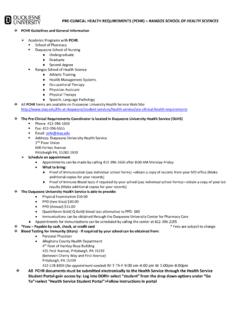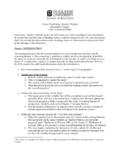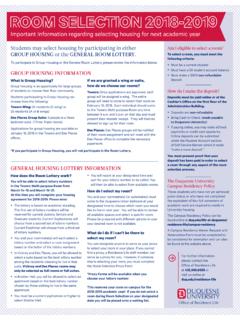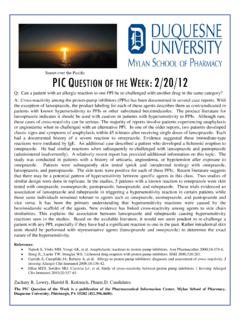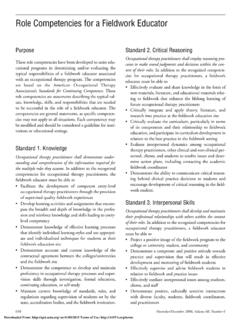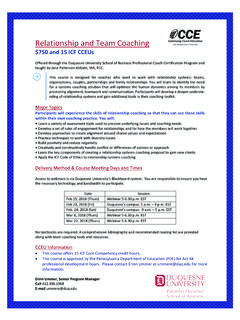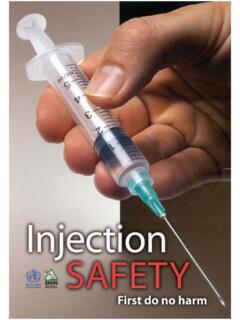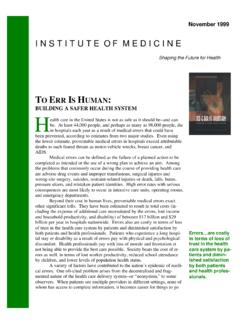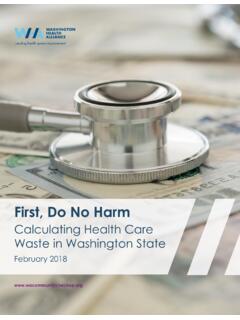Transcription of First, Do No Harm - duq.edu
1 NAM Special PublicationMarshaling Clinician Leadership toCounter the Opioid EpidemicNAM Special PublicationFirst, Do No HarmAn NAM Special Publication first , do no harm Marshaling clinician leadership to counter the opioid epidemic NATIONAL ACADEMY OF MEDICINE Washington, DC NATIONAL ACADEMY OF MEDICINE 500 Fifth Street, NW Washington, DC 20001 NOTICE: This publication has undergone review according to procedures established by the National Academy of Medicine (NAM). Publication by the NAM signifies that it is the product of a carefully considered process and is a useful contribution worthy of public attention, but does not represent formal endorsement of conclusions and recommendations by the NAM.
2 The views presented in this publication are those of individual authors and do not represent formal consensus positions of the authors organizations, the NAM or the National Academies of Sciences, Engineering, and Medicine. Support for this activity was provided by the National Academy of Medicine. Library of Congress cataloguing data to come Copyright 2017 by the National Academy of Sciences. All rights reserved. Printed in the United States of America. Suggested citation: National Academy of Medicine (NAM). 2017. first do no harm : Marshaling clinician leadership to counter the opioid epidemic. Washington, DC: National Academy of Medicine. Knowing is not enough; we must apply.
3 Willing is not enough; we must do. GOETHE ABOUT THE NATIONAL ACADEMY OF MEDICINE The National Academy of Medicine is one of three Academies constituting the National Academies of Sciences, Engineering, and Medicine (the National Academies). The National Academies provide independent, objective analysis and advice to the nation and conduct other activities to solve complex problems and inform public policy decisions. The National Academies also encourage education and research, recognize outstanding contributions to knowledge, and increase public understanding in matters of science, engineering, and medicine. The National Academy of Sciences was established in 1863 by an Act of Congress, signed by President Lincoln, as a private, nongovernmental institution to advise the nation on issues related to science and technology.
4 Members are elected by their peers for outstanding contributions to research. Dr. Marcia McNutt is president. The National Academy of Engineering was established in 1964 under the charter of the National Academy of Sciences to bring the practices of engineering to advising the nation. Members are elected by their peers for extraordinary contributions to engineering. Dr. C. D. Mote, Jr., is president. The National Academy of Medicine (formerly the Institute of Medicine) was established in 1970 under the charter of the National Academy of Sciences to advise the nation on issues of health, medicine, and biomedical science. Members are elected by their peers for distinguished contributions to medicine and health.
5 Dr. Victor J. Dzau is president. Learn more about the National Academy of Medicine at v AUTHORS SUSAN M. ADAMS, Professor of Nursing, Vanderbilt University, Nashville, TN CARLOS BLANCO, Director, Division of Epidemiology, National Institute on Drug Abuse, Bethesda, MD HUMAYUN J. CHAUDHRY, President and Chief Executive Officer, Federation of State Medical Boards, Washington, DC HARRY CHEN, Commissioner, Vermont Department of Health, Burlington, VT (former) ROGER CHOU, Professor of Medicine, Oregon Health and Science University, Portland, OR MELISSA CHRISTOPHER, National Director, Academic Detailing, Department of Veterans Affairs, Washington, DC PATRICE A.
6 HARRIS, Chair, Task Force to Reduce Rx Opioid Abuse, American Medical Association, Washington, DC SAUL M. LEVIN, Chief Executive Officer and Medical Director, American Psychiatric Association, Arlington, VA SEAN MACKEY, Chief, Division of Pain Medicine, and Redlich Professor of Pain Medicine, Stanford University, Palo Alto, CA ELINORE McCANCE-KATZ, Chief Medical Officer, Rhode Island Department of Behavioral Healthcare, Providence, RI (now Assistant Secretary for Mental Health and Substance Abuse, Department of Health and Human Services, Washington, DC) PAUL A. MOORE, Professor, School of Dental Medicine, University of Pittsburgh, Pittsburgh, PA JAMES P.
7 RATHMELL, Chair, Department of Anesthesiology, Perioperative, and Pain Medicine, Brigham and Women s Hospital and Professor of Anesthesia, Harvard Medical School, Boston, MA TRAVIS N. RIEDER, Assistant Director for Education Initiatives, Berman Institute of Bioethics, Johns Hopkins University, Baltimore, MD BOB TILLMAN, Executive Director, Academy of Integrative Pain Management, Lenexa, KS NAM Staff This publication was facilitated by the following NAM staff, under the guidance of Michael McGinnis, NAM Leonard D. Schaeffer Executive Officer and Executive Director of the Leadership Consortium for a Value & Science-Driven Health System: MONICA GONZALEZ, Associate Program Officer EMMA FINE, Senior Program Assistant MICHELLE JOHNSTON-FLEECE, Senior Program Officer KYRA E.
8 CAPPELUCCI, Communications Associate LAURA HARBOLD DESTEFANO, Director of Communications BROOKE KEAN, Internvi ACKNOWLEDGMENTS This special publication was reviewed in draft form by individuals chosen for their diverse perspectives and technical expertise, in accordance with review procedures approved by the National Academy of Medicine. We wish to thank the following individuals for their review of this publication: RICHARD J. BONNIE, Director, Institute of Law, Psychiatry, and Public Policy, University of Virginia, Charlottesville, VA KATHRYN CATES-WESSEL, Chief Executive Officer, American Academy of Addiction Psychiatry, East Providence, RI DEBORAH DOWELL, Chief Medical Officer, Division of Unintentional Injury Prevention, Centers for Disease Control and Prevention, Atlanta, GA CHRISTINE GLEASON, Professor, University of Washington, Seattle, WA TAMARA HAEGERICH, Associate Director for Science, Division of Unintentional Injury, Centers for Disease Control and Prevention, Atlanta, GA CHRISTOPHER JONES, Director, Division of Science Policy.
9 Department of Health and Human Services, Washington, DC HAROLD PINCUS, Professor, Columbia University, New York, NY vii CONTENTS Marshaling Clinician Leadership to Counter the Opioid Appendix A: Action Appendix B: Author first , do no harm Marshaling clinician leadership to counter the opioid epidemic The medical dictum primum non nocere ( first , do no harm ) is usually attributed to Hippocrates, and no therapeutic remedies in modern times provide a more poignant example of the injunction s warning than the balance between the legitimate value and inappropriate use of the substances derived from the plant of the opium poppy.
10 Provisional estimates suggest that nearly 65,000 Americans died from an overdose of drugs in 2016, a 21% increase from the previous year3 that represents a nearly eight-fold increase in the past 37 All of the data suggests that the escalation is due substantially to opioids, with nearly two-thirds of all recent drug deaths now attributable to opioid For the nation s clinicians, the burdens are heavy and multifaceted, contending as they must with the immediate consequences of the crisis for their patients, their colleagues, and their own families, as well as with the reality that a share of the responsibility for the problem s source lies with themselves.
